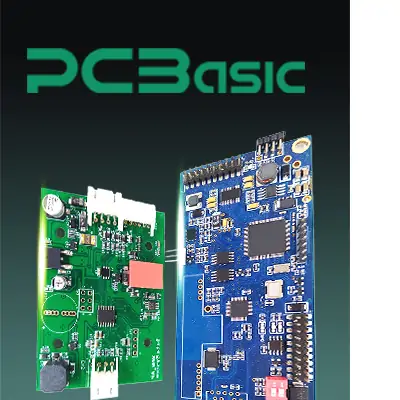

Global high-mix volume high-speed PCBA manufacturer
9:00 -18:00, Mon. - Fri. (GMT+8)
9:00 -12:00, Sat. (GMT+8)
(Except Chinese public holidays)


Global high-mix volume high-speed PCBA manufacturer
9:00 -18:00, Mon. - Fri. (GMT+8)
9:00 -12:00, Sat. (GMT+8)
(Except Chinese public holidays)
With the development of electronic technology, the production of electronic products requires more and more materials, such as high-frequency materials.
Take Rogers PCB as an example. Rogers PCB material is a kind of high-frequency board produced by Rogers Company, which is different from conventional PCB board epoxy resin. It has no glass fiber in the middle and is a ceramic-based high-frequency material. When the operating frequency of the circuit is above 500MHz, the range of materials available to design engineers is greatly reduced.
Rogers PCB material has excellent dielectric constant and temperature stability, and its thermal expansion coefficient of dielectric constant is very consistent with that of copper foil, which can be used to improve the shortcomings of PTFE polytetrafluoroethylene substrate. It is very suitable for high-speed design, as well as commercial microwave and RF applications.
Because of its low water absorption, it can be used as an ideal choice in high humidity environment, providing customers in high-frequency board industry with the best quality materials and related resources, and fundamentally controlling product quality.
Generally speaking, Rogers PCB high frequency board can be defined as PCB printed circuit board with frequency above 1GHz. Its physical performance, accuracy and technical parameters are very demanding, and it is often used in communication systems, automobile anti-collision systems, satellite systems, radio systems and other fields.
Rogers PCB board material RO3000® series:
Based on ceramic-filled PTFE circuit materials, the models are RO3003G2™, RO3003™, RO3203™, RO3035™, RO3006™, RO3010™, RO3210™ Rogers PCB board material RO4000® series: Ro4000 ceramic-filled hydrocarbon laminate and prepreg is a leading product series in the industry. The models include: RO4003C, RO4350b, RO4360G2, RO4830, RO4835T, RO4533, RO4534, RO4535, RO4725JXR and RO4730G3.
Rogers PCB board material RT/duroid® Laminate:
RT/Duroid® high-frequency circuit material is a composite laminate containing PTFE filler (random glass fiber or ceramic), which is suitable for high reliability, aerospace and national defense applications. Include: RT/duroid® 5880, RT/duroid® 5880lz, RT/duroid® 5870, RT/duroid® 6002, RT/duroid® 6202, etc.
Rogers PCB board material TMM® series:
Composite materials based on ceramics, hydrocarbons, and thermosetting polymers, model numbers: TMM3, TMM4, TMM6, TMM10, TMM10i, and TMM13i. etc.
1. Rogers PCB board substrate has low water absorption, and high-water absorption will cause dielectric constant and dielectric loss when it is wet.
2. The thermal expansion coefficients of Rogers PCB board substrate and copper foil must be consistent, otherwise, the copper foil will be separated during the change of heat and cold.
3. The dielectric loss (Df) of Rogers PCB board substrate material must be small, which mainly affects the quality of signal transmission. The smaller the dielectric loss, the smaller the signal loss.
4. The dielectric constant (Dk) of Rogers PCB board substrate must be small and stable. Generally speaking, the smaller the better; the signal transmission rate is inversely proportional to the square root of the dielectric constant of the material. The high dielectric constant is easy to cause signal transmission delay.
At present, the global 5G layout is accelerating. Traditional 3G/4G base station distributed architecture can be divided into BBU, RRU, and antenna feeder systems, in which RRU and antenna feeder systems are connected by the feeder. As the risk of transmission loss increases with high frequency, the architecture of integrated RRU and antenna feeder systems can reduce the signal loss on the feeder and improve transmission efficiency. The high integration means that a large number of scattered components are replaced by PCB boards, which ultimately increases the unit usage of PCB.

In rapid PCB prototyping, Rogers PCB is a special circuit board with a certain technical threshold, which is difficult to operate and high in cost. General PCB proofing factories are too troublesome to make, or because of the small number of customer orders, they don't want to do it or rarely do it.
Rogers PCB RO4350B material allows RF engineers to design circuits conveniently, such as network matching, impedance control of transmission lines, etc. Because of its low dielectric loss, RO4350B has more advantages than ordinary circuit board materials in high-frequency applications. The fluctuation of its dielectric constant with temperature is almost the lowest among similar materials. In a wide frequency range, its dielectric constant is quite stable, 3.48, and the recommended design value is 3.66. LoPra™ copper foil can reduce insertion loss. This makes the material suitable for broadband applications.
Rogers PCB RO4003 material can be removed with a traditional nylon brush. Before electroplating copper without electricity, no special treatment is needed. The board must be treated with a traditional epoxy resin/glass process. Generally, it is not necessary to remove the drilling hole because the high TG resin system (280°C+[536°F]]) does not easily change color during the drilling process. If the stain is caused by aggressive drilling operations, the resin can be removed by a standard CF4/O2 plasma cycle or double alkaline permanganate process.
The cooking requirements of RO4000 materials are equivalent to those of epoxy resin/glass. Generally, the equipment that does not cook epoxy resin/glass plate does not need to cook the RO4003 plate. For installing epoxy resin/baked glass as part of the conventional process, we recommend cooking at 300°F, 250 F (121 C-149 C) for 1 to 2 hours. RO4003 contains no flame retardant. It can be understood that boards packaged in infrared (IR) units or running at a very low transmission speed can reach temperatures in excess of 700 F (371 C). RO4003 can start burning at these high temperatures. The system that still uses the infrared reflux device or other equipment that can reach these high temperatures should take necessary precautions to ensure that there is no risk.
RO3003 is a ceramic filled PTFE composite for high frequency circuit materials, which is used in commercial microwave and radio frequency applications. This series of products is designed to provide excellent electrical and mechanical stability at competitive prices. Rogers PCB Ro3003 material has excellent dielectric constant stability in the whole temperature range, including eliminating the change of dielectric constant when PTFE glass material is used at room temperature. In addition, the loss coefficient of Ro3003 laminate is as low as 0.0013 to 10 GHz.
 About PCBasic
About PCBasic
Time is money in your projects – and PCBasic gets it. PCBasic is a PCB assembly company that delivers fast, flawless results every time. Our comprehensive PCB assembly services include expert engineering support at every step, ensuring top quality in every board. As a leading PCB assembly manufacturer, we provide a one-stop solution that streamlines your supply chain. Partner with our advanced PCB prototype factory for quick turnarounds and superior results you can trust.
Before deciding whether to choose FR4 or Rogers PCBs, it is crucial to figure out what FR4 material is needed first. FR4 material is a very common substrate for circuit boards, which is made by laminating fiberglass cloth with epoxy resin. Its greatest advantages are its low cost and good mechanical strength, so it is widely used in various general electronic products, such as computer motherboards and TV circuit boards.
However, when your circuit needs to transmit high-frequency signals, FR4 material seems somewhat inadequate. Because its dielectric constant changes with frequency, which leads to large signal loss and performance degradation.
Here’s the comparison table between FR4 dielectric material and Rogers PCB material, showing differences in key properties, performance, and application suitability:
|
Feature |
FR4 Dielectric Material |
Rogers PCB Material |
|
Material Composition |
Fiberglass + epoxy resin |
Ceramic-filled PTFE or high-performance composites |
|
Dielectric Constant (Dk) |
Around 4.2–4.8, varies significantly with frequency |
Stable, typically between 2.2–3.5, with minimal variation |
|
Signal Loss at High Frequency |
Higher, prone to signal attenuation |
Very low, ideal for high-frequency transmission |
|
Performance Stability |
Moderate, unstable at higher frequencies |
Excellent, maintains consistent electrical performance |
|
Thermal Performance (CTE) |
Higher expansion, prone to deformation under heat |
Low expansion, highly thermally stable |
|
Manufacturing Difficulty |
Easy to process, widely supported |
Requires specialized handling and equipment |
|
Cost |
Low, ideal for mass-market, low-frequency electronics |
Higher, best for high-end or RF applications |
|
Typical Applications |
Consumer electronics, computers, general PCBs |
5G infrastructure, RF systems, radar, satellite communication |
|
Hybrid Stack-up Compatibility |
Often used in hybrid builds |
Commonly combined with FR4 for balanced cost and performance |
When choosing between FR4 dielectric material and Rogers PCB material, the most important factor is where your circuit will be used:
FR4: If you're working on general-purpose, low-frequency electronic products with a limited budget, then FR4 is already good enough.
Rogers PCB: But if your circuit needs to handle RF signals, microwaves, or high-speed digital signals (such as 5G communication or radar systems), it's better to use Rogers PCBs because they offer more stable performance and lower signal loss.
Of course, sometimes both materials can be used together — combining Rogers circuit board material and FR4 dielectric material on the same board. This way, you can ensure performance while also saving costs. It's a common approach in many advanced applications.
In the fields of radio frequency (RF) and microwave, the PTFE PCB (polytetrafluoroethylene PCB) is a very important high-frequency circuit board. Its most outstanding features are extremely low signal loss, strong transmission performance, and can withstand high temperatures. So it is often used in some devices with high-performance requirements, such as radars, satellite communications, 5G base stations, high-frequency communication modules, etc.
Many high-quality Rogers PCB materials are actually developed based on PTFE. For instance, Rogers' RT/duroid series and RO3000 series all belong to PTFE PCBS. These materials can maintain a stable dielectric constant in high-frequency environments, with very low signal transmission loss, making them highly suitable for high-speed and RF circuits.
In contrast, traditional FR4 PCBs perform less well at high frequencies: their dielectric constants are unstable and signals are prone to attenuation, making it impossible to produce high-performance products. So if you are working on high-frequency or high-reliability projects, such as 5G or radar, it would be more appropriate to choose Rogers circuit board materials or PTFE PCBs.
At present, the global 5G layout is accelerating. Traditional 3G/4G base station distributed architecture can be divided into BBU, RRU, and antenna feeder systems, in which RRU and antenna feeder systems are connected by the feeder. As the risk of transmission loss increases with high frequency, the architecture of integrated RRU and antenna feeder systems can reduce the signal loss on the feeder and improve the transmission efficiency. The high integration makes a large number of scattered components replaced by PCB boards, which ultimately increases the unit usage of PCB.
The 5G era must make use of the high-frequency band (3GPP has specified that the frequency range supported by 5GNR is 450MHz-52.6GHz) because:
1. After the iteration of the first four generations of communication technologies, the resources in the low-frequency band have been occupied, and there are not many resources available for 5G development;
2. The higher the frequency, the more information can be loaded, the richer the resources, and thus the higher the transmission rate (for example, only five 20MHz channels can be divided in 100MHz, while 50 20MHz channels can be divided in 1GHz). Due to the resonance phenomenon caused by load and the influence of the transmission line effect, the higher the frequency of electromagnetic waves, the more severe the attenuation will be.
To realize efficient transmission at high frequency, it is necessary to control the loss of signals on the transceiver and transmission devices, and the corresponding bearing devices will be changed from ordinary plates in the past to high-frequency plates (such as Rogers PCB RO4350 material). Specifically, the terminal antenna originally used FPC (flexible printed circuit board) with PI as the main material, but due to the dielectric constant (Dk, The ability of medium to block electrons) and dielectric loss (Df, the ability of transmission medium to convert electric energy into heat energy) are both high, so the transmission efficiency is low. Therefore, the trend of replacing PI with liquid crystal polymer (LCP) with lower Dk and Df is becoming increasingly prominent.
At present, LCP has been introduced into Apple mobile phones, and LCP materials are expected to become mainstream materials in the future. Taking Apple as an example, the single LCP module in iPhone X is about 4-5 USD/antenna.
The base station also needs high-frequency materials (such as Rogers PCB RO4350 material). At present, the mainstream scheme is to use polytetrafluoroethylene (PTFE) or hydrocarbon PCB (with very good dielectric properties). The unit cost is increased by about 1.5-3 times. A high-frequency AC board is needed at the 3G/4G base station RRU. Among them, high-frequency materials (such as Rogers PCB RO4350 material) are needed for the PCB of RF power amplifiers. The demand for high-frequency (such as Rogers PCB RO4350 material) PCB board for 5G AAU medium and high-frequency AC board will increase, and the amount of high-frequency materials used in PCB board will increase, thus increasing the value of a single board.

High-frequency PCB board is a special kind of copper-clad laminate with high-frequency microwave substrate, also called high-frequency microwave PCB board, which can be made into high-frequency PCB by further processing. Rogers PCB board made of Rogers PCB high-frequency material is widely used in communication base station and antenna aviation, with high demand and promising market prospects.
As the world's leading supplier of special plates, Rogers Board has a global market share of over 50%, and has 20 years of industry experience in the field of base station antenna radio frequency. The company has set up a third R&D center in the United States, focusing on the R&D of 5G products, and has launched a high-frequency board for 5G antenna RF. With the expansion of the 5G commercial scale, the company is about to usher in high-performance flexibility.
The market is aware that 5G has a large demand for high-frequency boards, but it doesn't know that the biggest demand elasticity is Rogers PCB board for base station antennas. As the frequency band of the 5G application is higher than 4G, it is necessary to adapt to the Rogers PCB board of millimeter wave, and the development trend of the antenna will turn to multi-reception, multi-transmission, and miniaturization. The number of antenna ports has increased from the traditional 4-port and 8-port to 64-port and 128-port, and the demand for Rogers PCB board for antenna application has increased dramatically.
After industry research, it is conservatively estimated that the procurement cost of initialization materials for a 5G antenna is 3-4 times that of a 4G multimode antenna, and the number of Rogers PCB boards used in multi-receiver and multi-transmitter antenna is higher than that of multimode antenna. Therefore, the market space of a high-frequency board for a 5G base station antenna is expanded by at least 4-6 times. With the advent of the 5G commercial era, the Rogers PCB board market has a broad prospect.
Assembly Enquiry
Instant Quote
Phone contact

+86-755-27218592
In addition, we've prepared a Help Center. We recommend checking it before reaching out, as your question and its answer may already be clearly explained there.
Wechat Support

In addition, we've prepared a Help Center. We recommend checking it before reaching out, as your question and its answer may already be clearly explained there.
WhatsApp Support

In addition, we've prepared a Help Center. We recommend checking it before reaching out, as your question and its answer may already be clearly explained there.
